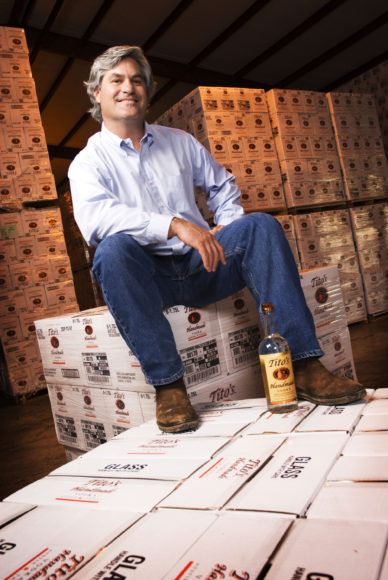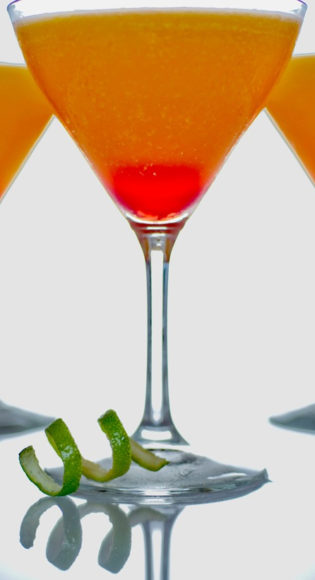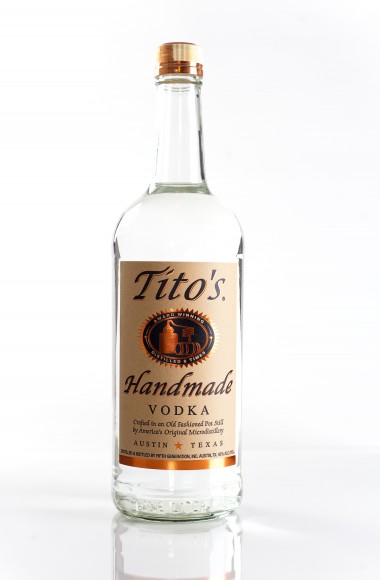Bert “Tito” Beveridge
By David Ransom

Ask for a vodka in Austin Texas, and invariably you’ll be asked the question, “you want OUR vodka or one from somewhere else?” That question says a lot about Texas, a proud and independent state, and if John McCain hasn’t ruined the term for the rest of us, the place where the word maverick was coined. One of the state’s true mavericks is a laid-back Texas native named Bert “Tito” Beveridge, a former geologist in the oil industry who ditched it all to follow his dream; and that vodka, “our” vodka as they say in Austin, is Tito’s.
Growing up in San Antonio, having a vodka bottle with his name on it was probably the last thing on Tito’s mind. While his interests certainly leaned towards the scientific, distilling is, after all, a science as well as an art, Tito’s original goal in life was to become a doctor. And it was with that in mind that Tito excelled in all things science related in school, eventually enrolling as a pre-med student at Vanderbilt University. However, like so many students, his focus changed as he went through college, and he ended up realizing that his true talent lay in the science of the earth, not the body. So tissue-covered slides and dissecting fetal pigs gave way to seismology and geology, and upon graduation, and armed with his degree, he returned to Texas, Houston to be exact, and entered the oil industry as a seismic data processor for a major oil company.
That time, the 1980’s, was a boom-time for the oil industry, with Texas-based companies expanding into countries all over the world. Tito did well also, eventually getting coveted contracts to work throughout the global oil fields and spending large blocks of time in countries like Venezuela and Columbia doing those things that energy geophysicists do, like sub-surface mapping and dynamite-blasting oil reserves.
However, he also had that classic Texas streak of independence running through his veins, and after a few years on the road, he tired of it and returned to his home state, settling in a town called Alvin; a place he calls “a hotbed of KKK activity” where he was actually invited to Klan meetings (which he politely declined).
It was in Alvin that he hung out his own shingle, becoming a wildcatter (an independent oilman, for those of you who haven’t seen the classic James Dean/Rock Hudson/Elizabeth Taylor movie, Giant) and starting his own drilling company. While drilling was a good way to make a living, he didn’t love it, and soon was back on the road again, eventually ending up in Austin working on environmental projects and finally, once he’d had enough of the Oil business for good, as a mortgage broker.
But going from blowing up mountains to moving mountains of paperwork, also seemed unappealing after awhile, and by the early 1990’s, Tito, who by that time had started infusing bottles of store-bought vodka and giving it to friends in his spare time, was at a crossroads, wondering what made him happy, and what to do with his life that would have meaning. So, after a quick trip to the backside of Maui, where he spent four days camping at the Seven Sacred Pools, reflecting on, to quote the great author Douglas Adams, “Life, The Universe, and Everything” (RIP Douglas, I had to do it…), Tito returned to Austin, and, after attending a keg party where someone recognized him as “that vodka guy” while he was filling his cup at the tap, returned home that evening thinking that maybe he should look into the spirits industry.
As fate would have it, late that night on television, he saw a program featuring some Tony Roberts type guy, who said the following words, “If you want to find your dream job, find your passion. Then sit down with a pen and paper, draw a line down the middle of the page, and on the left make a list everything you love to do, then on the right, write down what you are good at doing. Once you’ve done that, find what you’re best suited for, and make it happen.” Well, Tito grabbed a pen and paper and did just that…why not? He’d just come home from a keg party, and it was the middle of the night? No harm, right?
No harm indeed. Upon finishing this “profound exercise of self-reflection” Tito realized he was drawn to meeting new people, was good at selling, and liked making spirits.
Shortly thereafter, while talking to the owner of his local liquor store about his idea of starting his own distillery, the store owner said to him, “Could be done, hasn’t, but could be, and if you can make a vodka really smooth that girls could drink straight, then people just might buy it.” With that in mind, he promptly started making inquiries as to how to get into the business, more importantly, the vodka business, since that was his spirit of choice, and he figured making vodka was probably a “great way to meet girls and write off my bar tab…”

Of course, some things in life are easier said (or thought) than done, and this was certainly true when it came to distilling in Texas. At the time, now 1993, there was not one distillery in the state of Texas, and the laws on the books had probably been un-revised or challenged since prohibition. And when he approached the Texas Alcoholic Beverage Commission (TABC) to apply for a license, he was told the law strictly forbids starting one. But big old law books full of legal code didn’t deter Tito. He knew how to read and interpret state codebooks from his days as a geologist. So he went to work and soon found that there actually was NOT any code forbidding it. When he went back to the TABC and showed them his findings, they finally said that if he could get a federal license, then they would issue him a state license.
Getting a federal license took two years, but he finally got one, and upon presenting it to a thoroughly impressed TABC, they at last issued him a license to distill; the first in the state.
Now after years of trying, the vision of Tito’s Handmade Vodka was a reality, and all he had to do was learn how to actually do the distilling, (and of course, figure out how to finance it all). Neither turned out to be easy. Tito spent some time visiting the bourbon distilleries up north, and found one guy from Jim Beam (who will remain nameless) who gave him a lot of advice and gave him tips on “micro” distilling, which they had started doing with some of their small batch bourbons. Armed with that, and other insights he had gathered along the way, Tito went home and being as he says “a bit of a tinkerer,” built a pot still from scratch. He then went to work figuring out his recipe one batch at a time, playing with different grains, until he finally settled on corn for his vodka. (Tito’s, distilled six times, is a 100% corn vodka).
Paying for it was a different story altogether, and the way Tito did it probably will never be a model case study in any business school. Bank after bank turned him down when he asked for a loan, and every person he approached to invest did the same, yet an undeterred (insert maverick here) Tito was more determined than ever to make his dream succeed.
It being the mid 1990’s, the economy was pretty good, and Tito found that those same banks who would not give him a loan, were sending him credit card offers all the time in the mail. So he started signing up and basically financed his whole operation on 19 credit cards, at one point running up $90,000 in charges and fees. This huge debt, along with the fear that he’d be tossed in jail for lying on his applications if he defaulted, and the “growing” fact that his girlfriend was now pregnant, as he now reflects, “Forced me to make it a success.”
And a success it now is. Tito’s, 14 years after selling its first case in 1997, is sold in all 50 states, and has an annual case production well into six figures. Micro? Not anymore, but definitely handcrafted, and along the way it has won accolades and awards all over the world, including a coveted Double Gold Medal at the San Francisco World Spirits Competition, which he firmly believes broke the market open for him.
Tito no longer uses that original still he built, and has moved from the shack he was distilling in behind his house (which he says doubled for a while as a daycare center for his kid, as yet unconfirmed by the kid or the mother), into an actual distillery which he recently furnished with a brand new custom-made 12,000 gallon still.
He still is in the distillery every day, testing batches and working the business, and all decisions run through him. He never did find an investor, yet after years of having doors shut in his face, he was finally offered a line of credit by an investment firm, which he accepted. “Hey, you never know when you’ll need to finance that next step” he says with a twinkle in his eye.
I sat down with Tito recently, just before he once again jetted off to Hawaii for a vacation, this time with his wife Lori and three children. He had a few things to say about his product and how it came to be:
Q. How did you settle on corn for your vodka?
A. I went through a lot of trials with those first batches, constantly using different grains and making my friends taste them as I went along. I was pretty popular, really, as my friends all got to drink for free while I figured out the formula. But in the end, corn gave me the taste I wanted, I just like the way it felt on the palate and tasted when I sipped it.
Q: On that note, do you consider Tito’s a sipping vodka?
A: I do. That’s usually the way I have it; chilled of course. Sometimes I may add a wedge of lime or slice of orange. Other times I may pour in a splash of sparkling water, but I always want to be able to taste the vodka, so I rarely make a cocktail for myself.
Q: But you obviously don’t mind if others do so, like bartenders, etc?
A: Of course not! One of the joys of drinking any spirit is the way it’s interpreted in the glass. If someone wants to use Tito’s, I’m all for it.
Q: Like the Redbud, created by Jeff Boley of Austin’s Paggi House?
A: Exactly. A wonderful drink…
Q: With the drought in Texas ruining this year’s crops, where do you get your corn from?
A: I’ll tell you, I feel for all the farmers in this state. It’s far worse than most people imagine, simply devastating. However, I’ve never relied on strictly Texas corn for Tito’s. I want my corn to have certain qualities, and I work with a regular group of farmers throughout the Midwest to ensure I get consistently even grain, which in turn gives the same consistency to my vodka. Very important if you want repeat customers.
Q: What was your last big learning experience?
A: This business teaches me something every day, good and bad. I like the good more. However, one of my biggest learning experiences came a number of years ago, when my name was just getting national attention. One day I got a call from the legendary Sidney Frank, who wanted to discuss making a vodka. We ended up having talks for six months, and then the phone lines went cold. I couldn’t figure it out, and then all of the sudden Grey Goose appeared in the market… that taught me a lot.
Q: One of the first reviews of Tito’s likened it to Beethoven’s Ninth Symphony. Does that mean it’s unfinished?
A: (laughs) hardly…
Q: The great mixologist Tony Abou-Ganim is one of your biggest fans, tell me how that came to be?
A: Tony’s a great guy. That all started after the Double Gold in San Francisco. Tony was a judge, and he fell in love with the product, subsequently tracking me down and inviting me to come to Las Vegas, where he lives, to give a seminar on vodka. I actually had no idea who he was when he called, apologized for not being able to make it and turned him down flat. At the time I had a broken pump that needed fixing, and money was tight, so I told him I’d tape his name and number on my wall and think about it later if I had the chance. Luckily he was persistent. He kept calling, and I did end up eventually going.
Q: Vodka producers always seem to want to publicize how many times they distill their vodka. I’ve seen one who claims to have run it through 37 times. You claim Tito’s is distilled six times. Do you really think it matters after a certain point?
A: I think it does, but it also depends on what you’re starting with and what kind of still you have. Some stills are built to put in more flavor and some are built to lean it down. I found during the learning process that my corn distillate tasted best after six runs through my still, so that’s my formula. However each batch is different, and remember, the more times you run it through, the more you change it, so there’s give and take there. For us, six works as a rule, but we taste every batch, and if sometimes it needs a seventh or only a fifth, so be it. If I can make it clean, with good body and without distilling it too many times, I like that best.
(Us too…)
Q: What are your plans for Tito’s over the next 10 years?
A: Well, we’ve just entered Canada, our first international market, so we will probably start moving into a global marketing philosophy at some point during that period, although I’m not pushing it. I think my big dream is to be one of this country’s top 5 spirits by 2020. That would do nicely…
Yes it would. And if Tito keeps thinking the way he always has, like a Texan, he’ll probably make it happen.
The Redbud
created exclusively for Tito’s Handmade Vodka by Jeff Boley, mixologist at Paggi House, in Austin
1 1/2 oz Tito’s Handmade Vodka
1/8″ Wheel Mariachi Pepper (or another medium-heat pepper)
1/2 oz House-Made Grenadine
juice from whole orange
juice from 1/2 a lime
dash of Sea Salt
dash of Fee Brothers grapefruit bitters
3 Pomegranate seeds
In a mixing glass muddle the Mariachi Pepper, Grenadine, Bitters and Sea Salt.
Add the lime, orange juice, Tito’s vodka and ice.
Shake, strain and sink with a dash of grenadine and garnish with the pomegranate seeds.

